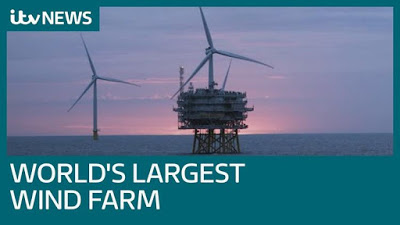Scotland Renewables making enough Electricity to power Two Scotlands and other Wind Power Successes
 |
| 07/27/2019 |
As The Independent put it in its headline, for the first six months of this year, Scotland generated enough electricity with wind turbines to power two Scotlands (with regard to household energy requirements).
Of course, households are not the only consumers of electricity– industry and retail are big in that regard, as well. But we are still at the beginning of Scotland’s green energy revolution. Scottish Power, the major utility, has dropped gas and coal entirely, and will invest $5.79 billion in order to double its renewables capacity. Not since the invention of the steam engine in Scotland in the 18th century has the country been such a bellwether for global energy trends. Scotland is a small country of 5.4 million and some of its policies are constrained by the much bigger country of England within the United Kingdom. New UK prime minister Boris Johnson, according to edie.net has a bewilderingly mixed record on renewable energy, supporting a low emission zone when mayor of London but voting against other renewables initiatives when an MP. It is likely that England and the Conservative Party will go on being a drag on renewables, but also likely that the economics will allow wind power to prove victorious nevertheless.
Kenya has opened Africa’s largest wind farm, generating some 300 megawatts of electricity. Kenya has a goal of generation 100% of its electricity from renewable sources by next year, The Lake Turkana Wind Power farm takes advantage of a high wind corridor some 500 miles north of Nairobi. Kenya has also been a pioneer in geothermal power, as I reported in 2012, and already gets 70% of its electricity from renewable sources. Still, enormous challenges remain, inasmuch as about 44% of the country still lacks electricity, and while it will be possible to supply it from wind, solar and geothermal, doing so will require upright and far-seeing officials declining bribes from the failing hydrocarbon industry.
Evwind reports that Egypt wants to get 7 gigawatts of wind-generated electricity by 2023, in only 4 years. By 2022, Egypt wants 20% of its electricity mix to be from renewables. It is constructing a massive $400 million wind farm at Ras Gharib in the Gulf of Suez with a consortium that includes the lead company, France’s Engie, along with Egypt’s Orascom Construction “and the Japanese companies Toyota Tsusho Corporation and Eurus Energy Holdings Corporation.” Egypt has little in the way of hydrocarbons and a fast-growing population already 100 million strong, and shortage of electricity and the high cost of importing coal and gas are big drags on its economy. Its government appears finally to have realized all this. It may not hurt that Egypt has poor relations with gas-producing Qatar and problematic relations with gas-producing Russia, whereas its patrons, Saudi Arabia and the United Arab Emirates have petroleum, not gas. If this hypothesis has anything to it, we should expect to see Egypt promote renewables in electricity but put obstacles up to electric vehicles (which hurt petroleum-producers).
Morocco is forging ahead with its plans to get 42% of its electricity from renewables by just next year. By 2030 it wants 2 new gigawatts each of solar, wind and hydro. Morocco already has 120 MW of wind power, making it third in Africa after Egypt and Kenya, but is only at the beginning of opening a string of wind farms. It is also planning for 2020 the tallest wind turbine in Africa, which will generate 3.6 megawatts all on its own and rise to 144 yards/meters or so.
Wind produced over a fifth of Spain’s electricity in the first half of 2019. Over half of electricity production came from renewables (33.3%) and nuclear (22.3%). About 56% of electricity in Spain came from low- or no-emission sources. Spanish energy giant Repsol plans another 800 megawatts, a small nuclear plant worth, of new wind and solar by 2024. Spain’s new Socialist government plans to phase out coal and nuclear in favor of renewables.
The long years of conservative governance have set Spain way back on solar, though, and the country is missing out on enormous opportunities for cheap photovoltaic and concentrated-solar electricity. Since the Socialists in April repealed the braindead conservative tax on solar electricity (put in to help the gas industry, which found ways to bribe them to do it), solar has seen a huge sudden jump and the sector is expect to expand by 1,600 % this year. The Olive Press notes, “The newly installed power will be made up of 4,000 MW of power from large-scale plants, and 400 MW from personal consumers.”
One lesson from Spain is that the only way for hydrocarbons to compete now is to find corrupt politicians like Mariano Rajoy to do social engineering to punish artificially the installation of cheap, clean renewables, harming the public for the sake of dirty, planet-wrecking plutocrats. The other lesson is that such legislation can be enormously efficient in maintaining the production of planet-destroying carbon dioxide. The Spanish public put Pedro Sanchez in as their leader in part on this issue, of Rojoy’s “sun tax,” showing that you can’t fool all of the people all of the time.


